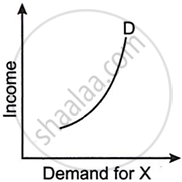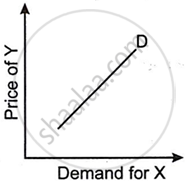Advertisements
Advertisements
Question
Do you agree with the following statement? Give reason
There are no exceptions to the law of demand.
Solution
No, the law of demand has certain exceptions. Some of such exceptions are listed below:
- Giffen goods: These are extremely inferior goods. With a fall in price of the Giffen goods, their demand falls.
- Emergency situations: In case of emergency situations such as war, curfew, natural calamities etc consumers purchase the commodities even at a higher price.
- Articles of distinction: Articles such as diamonds, jewellery, etc. are accorded high prestige and status as these are very costly. Such articles enjoy a high demand because of their high price. Consequently, the demand for such goods share a positive relationship with price.
APPEARS IN
RELATED QUESTIONS
Explain the law of demand with its assumptions.
State and explain the ‘law of demand’ with its exceptions.
When does ‘increase’ in demand take place?
Explain the effect of change in prices of the related goods on demand for the given good.
Market of a commodity is in equilibrium. Demand for the commodity "increases." Explain the chain of effects of this change till the market again reaches equilibrium. Use diagram.
Prices of other goods and demand for the given good.
Explain how do the following influence demand for a good:
i. Rise in income of the consumer.
ii. Fall in prices of the related goods
Distinguish between individuals demand and market demand.
Good Y is a substitute of good X. The price of Y falls. Explain the chain of effects of this change in the market of X.
If with the rise in the price of good Y, demand for good X rises, the two goods are: (Choose the correct alternative)
a. Substitutes
b. Complements
c. Not related
d. Jointly demanded
How does change in the price of a substitute good affect the demand of the given good? Explain with the help of an example.
What does a rightward shift of demand curve indicate?
Fill in the blank using proper alternative given in the bracket:
Market demand is a total demand of...............buyers.
Define or explain the following concept.
Market Demand .
State with reason, whether you Agree or Disagree with the following statement.
The demand curve slopes downward from left to right.
Write explanatory notes or answer the following.
Aggregate demand
Do you agree with the following statement? Give reason
State and explain the law of demand.
Statements related to decrease in demand
- It is a type of change in demand
- It takes place due to unfavourable changes in other factors like tastes, income etc.
- Price remains constant
- Demand curve shifts to the right hand side of the original demand curve
Assertion (A): Under exceptional cases, demand curve has a positive slope.
Reasoning (R): In exceptional cases, consumer buys more when the price of a commodity rises and buys less when the price of commodity falls.
The shape of supply curve is ______
The demand curve for foreign exchange is ______
Identify the correctly matched items from Column I to that of Column II:
| Column I | Column II |
| (1) Demand Curve of Perfect Competition | (a) V-shaped Curve |
| (2) Demand Curve of Monopoly | (b) U-shaped Curve |
| (3) Demand Curve of Monopolistic Competition | (c) Upward rising |
| (4) Demand Curve of Oligopoly | (d) In-determinant |
Assertion (A): The demand curve is downward sloping.
Reason (R): The income effect means with a fall in the price of a good, the consumer's real income or purchasing power rises and he demands more units of the good.
In case of perfect competition, AR curve is:
Explain why the demand curve slopes downwards.
- Assertion (A): The demand curve slopes downwards.
- Reasoning (R): A fall in the price of goods increases the real income of the consumer enabling him/her to buy more.
Study the following diagram and answer the questions:

Questions:
- In which direction does the demand curve slope?
- What is the reason for the fall in demand of rice from Q0 to Q1?
Figures (A), (B) and (C) given below represent different types of Demand curves.
 |
 |
 |
| (A) | (B) | (C) |
What kind of goods do each of these Demand curves represent? Give a reason for each of the curves.
Draw a straight-line demand curve joining both the axes. Indicate the following on the demand curve.
Elasticity of demand is equal to zero
